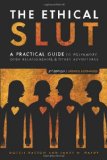I am leading a read-through of The Ethical Slut, 2nd edition. If you’d like to catch up on past installments, check the list at the bottom of the series introduction. Comments on the topics in this discussion are welcome anytime, even from people who aren’t following along in the book.
This week, a discussion inspired by Chapter 14, “Embracing Conflict.”
When fans of The Ethical Slut talk, they often say that it is useful to people in all kinds of relationships whether they are monogamous, or even if they are celibate. Often they are thinking of chapters like this one. Conflict is inevitable, after all, any time humans interact for any length of time. This is true whether they are intimate or even if they never meet in person; we’ve all seen how fast drama can appear on the Internet where people would never think of causing it in person.

“… the experiences that we share when we feel flayed, with our skins off, scared and vulnerable, and our partner is there with us, willing to share in the scary stuff. These are the times that bring us the closest together.” –from The Ethical Slut, second edition
Coming on the heels of the “Clean Love” interlude, which imagines an idealized form of interaction, the authors dive right into the muck of the messiest part of love.There are a lot of valuable tools here for helping readers feel like conflict is “another fucking opportunity for growth” and less like a hopeless disaster every time there is the slightest bit of friction. The skills in this chapter are applicable to anyone but regardless of how much it applies to monogamists, I do believe the polyamorous need conflict resolution skills more than most. It’s not that our lives are inherently dramatic, but because freedom stirs strong emotion. We’re out exploring new forms of relationships with few guides (as much as books like this help) and little support from the larger culture; we’re bound to make some unique and sometimes fairly spectacular mistakes.
As this chapter emphasizes, all of us bring baggage and triggers from our childhood and past relationships to our current ones. We have to own what belongs to us and not be afraid to ask for help when we need it, to not be afraid to speak up for our needs. In the process we have to be fair to our partners — when conflict becomes a competition to see who will “win,” the participants have really lost sight of their shared partnership. That’s when we need to take time-outs or even longer breaks, sometimes rescheduling conflict resolution for later: when we have more time, when we are together physically instead of resorting to the phone, or when we aren’t so hungry, angry, lonely or tired (HALT).
The tools in this chapter are good ones, but on this read-through what struck me was not any new technique for my arsenal but how the reading stirred me to consider my progress in learning to deal with conflict better. On our walking trip around her Chicago neighborhood this afternoon, my mom told me how she had been less worried about me than other members of our family during her recent cardiac event because she knew that I could ask for help if I needed it and that I’d built a supportive and loving community around me. Neither of these were always true about me — there have been times when I felt profoundly isolated, and there were also times when it was a struggle for me to learn how to ask for what I need. In a weird way, kink has been a big help with that; I’ve learned to ask for support, and in return I’ve learned that the people around me are more than happy to offer that loving support if I just ask.

I’ve learned to accept of the differences the people have in my life in how they handle conflict. In my biological family, we talk about everything, and usually immediately and at great length. I think it’s just part of how we are, but it’s also influenced by the massive amounts of talk therapy we’ve all been through. When I first started dating my pet I struggled because, when she gets upset, she often needs to think things over for a while before she can talk about them. In return though, she’s excellent about telling me something is up. I’ve learned patience; she will bring it to me in her own time, when we can usually deal with the problem with relative ease.
For a while, I had a terrible time taking breaks even when I needed to because someone feels triggered or the situation had gotten out of hand. Then the pendulum seemed to swing the other way — I had been so hurt by a broken relationship that I fled from conflict at the drop of a hat, demanding a break the second I heard raised voices. Now I’m happy to realize that I’ve gotten back to a place of balance, able to handle things when they arise but take the time when needed.
I’m still far from perfect. For example, I catch myself thinking fatalistically sometimes when it’s not necessary, and this tends to over-inflate an issue’s importance. I’m sure I’ll improve with time and then face new challenges. In the end, I have to agree with Easton and Hardy about the growth that comes through this kind of adversity.
While some of the exercises in this chapter did not seem useful to me in my current situation, it was quite valuable to study my changing relationship with conflict. Now tell me about yours: how has your relationship with conflict, argument, fights and difficult situations changed over time? What challenges do you face now?
Because next Thursday marks the start of Burning Flipside, the read-along will return Thursday, June 2 with Chapter 15, “Making Agreements.” Also in the coming weeks, look for a guest post by Gyesika Safety, Flipside’s Sanctuary Lead, on managing and learning from conflict.